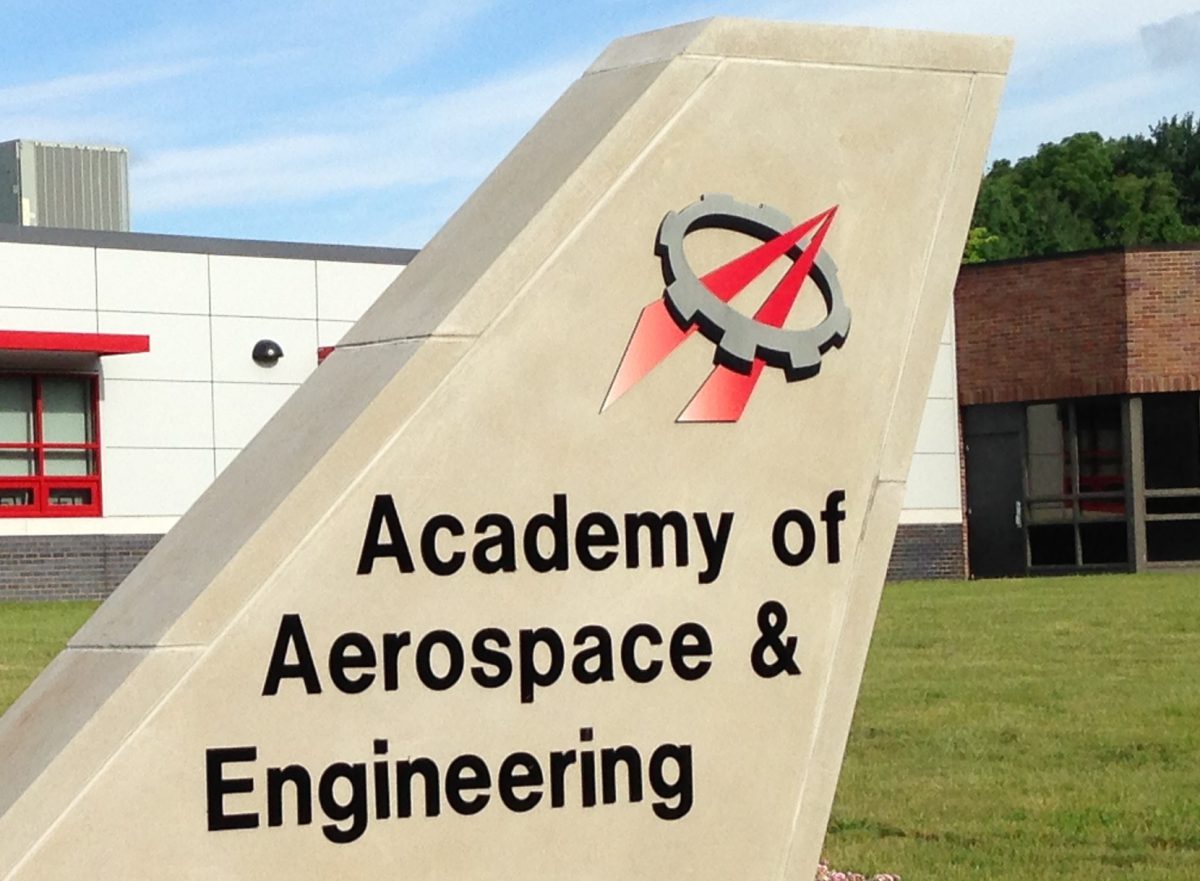At the Academy of Aerospace and Engineering students have been using model rockets as a medium for learning all aspects of science, technology, engineering, and math (STEM). First they studied the science of rocketry and its history. They also compared rockets and rocket engines to what they had learned about aircraft and jet engines. They learned how to measure altitude using basic trigonometry, a new type of math for them, but related to what they already knew. They did a science lab where they compared the performance of two different commercial model rockets. Then they did an engineering design challenge where they chose one of the two commercial model rockets and improved its design to make it fly higher. This challenge ended with launch tests on May 26th, followed by a class discussion and an analysis of the results. Six student crews (groups of 4 to 5 students) had each redesigned a rocket, changing the body tube, fins, recovery system, and/or nose cone to reduce weight and drag. Out of the six rockets, four achieved the goal of flying higher than the average height achieved by the commercial rocket, as measured during the science lab. One of the six proved to be unstable on launch and went out of control, tumbling end over end and not flying above about 20 feet. One blew up on the launch pad because it would not fly up the launch rod due to faulty construction. Because we had followed the Safety Code of the National Association of Rocketry, everyone was well clear of the launch area and nobody was ever in any danger from these mishaps. Therefore, four crews achieved success, and two crews failed in their design. I told the students I was glad these failures had happened…what?! Let me explain why.
The Next Generation Science Standards (NGSS), which were adopted by the state of Connecticut this year and guide our curriculum, have a major section dedicated to engineering design. I incorporated these standards in the academy curriculum as I wrote it last year. Here are the standards for middle school students that I use:
- ETS1.A: Defining and Delimiting Engineering Problems
- The more precisely a design task’s criteria and constraints can be defined, the more likely it is that the designed solution will be successful. Specification of constraints includes consideration of scientific principles and other relevant knowledge that are likely to limit possible solutions. (MS-ETS1-1)
- ETS1.B: Developing Possible Solutions
- A solution needs to be tested, and then modified on the basis of the test results, in order to improve it. (MS-ETS1-4)
- There are systematic processes for evaluating solutions with respect to how well they meet the criteria and constraints of a problem. (MS-ETS1-2), (MS-ETS1-3)
- Sometimes parts of different solutions can be combined to create a solution that is better than any of its predecessors. (MS-ETS1-3)
- Models of all kinds are important for testing solutions. (MS-ETS1-4)
- ETS1.C: Optimizing the Design Solution
- Although one design may not perform the best across all tests (my underline), identifying the characteristics of the design that performed the best in each test can provide useful information for the redesign process—that is, some of those characteristics may be incorporated into the new design. (MS-ETS1-3)
- The iterative process of testing the most promising solutions and modifying what is proposed on the basis of the test results leads to greater refinement and ultimately to an optimal solution. (MS-ETS1-4)
What these standards do not specifically say is that a design may fail to solve the problem. In other words, the student should expect that a design not only “may not perform the best across all tests,” but it might actually not perform at all — it might be a complete failure, as two out of the six rocket launch tests were. But what failure shows in stark reality to students is that the design did not work, and if this lesson is emphasized correctly, students will learn much more and remember the lesson much better than if everything worked and went smoothly. How did I do this with the rocket failures? I first have told the students all year that failure is part of the journey to success. We looked at many real-world examples, especially the record of SpaceX’s attempt to bring a rocket back and land it after launch. In December, right after SpaceX had achieved success in this attempt for the first time and after many failed attempts, we had a guest speaker, Eric Womer, who was a graduate of our middle school and is now a propulsion engineer for SpaceX. He explained very clearly how SpaceX and its founder, Elon Musk, have persevered through many failures to achieve success. Throughout this school year, my students have done several engineering design challenges, and in each one, some crews succeeded and some failed in their initial designs. Each time we discussed the results and learned from them. Now students are used to failure as a normal consequence of trying something new.
Yesterday I attended the graduation of my oldest son from Rensselaer Polytechnic Institute. One of the speakers at the graduation was renowned physicist, Steven Weinberg. The gist of his speech was that he learned the most in life from the times he was completely wrong about something. He gave a few examples, but essentially he was saying that he had learned from his failure to understand something correctly. In seeing his failure, he had been forced to reexamine what he had believed to be true, then he started over and rebuilt his beliefs. This is the same process as an engineer follows when a design proves to be a failure. In all cases, failure is just one of the expected steps on the road to new discoveries and ultimately to success. We are learning this at the Academy of Aerospace and Engineering, and maybe someday it will be in the NGSS.
Here are photos from the launch tests:




























